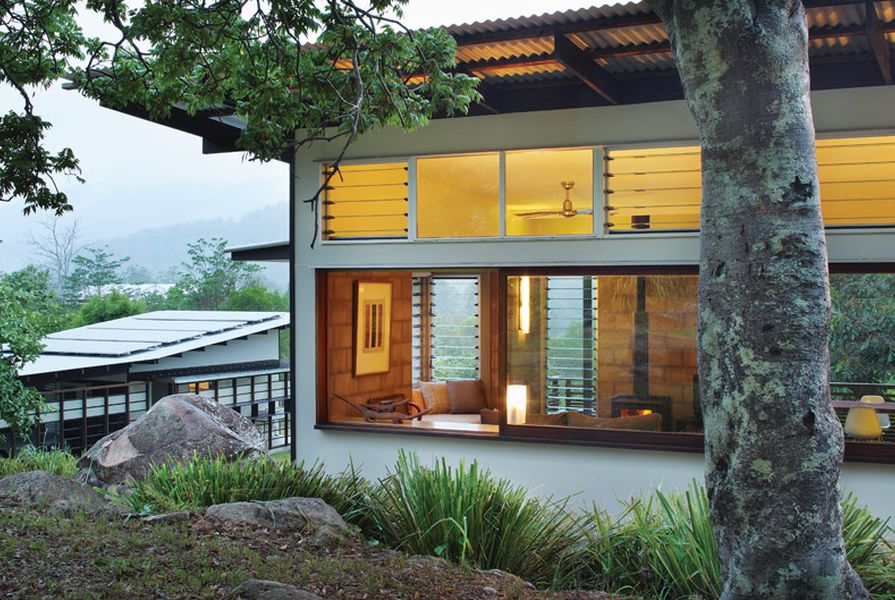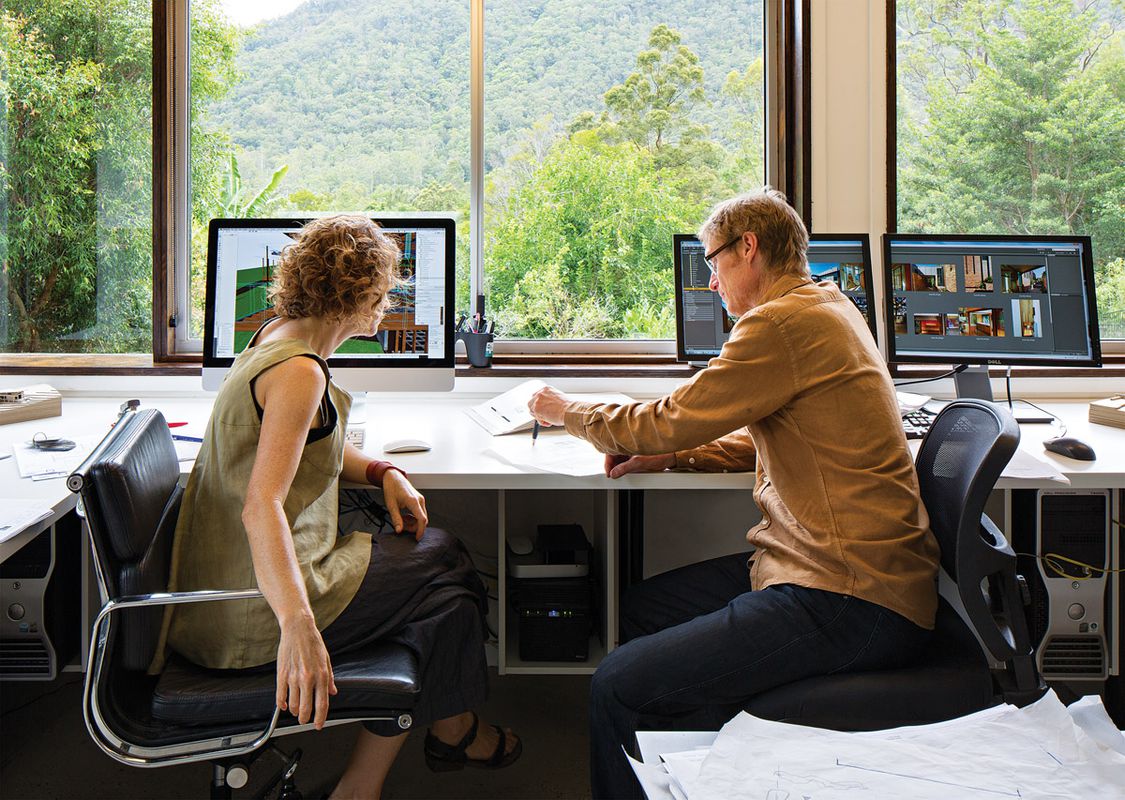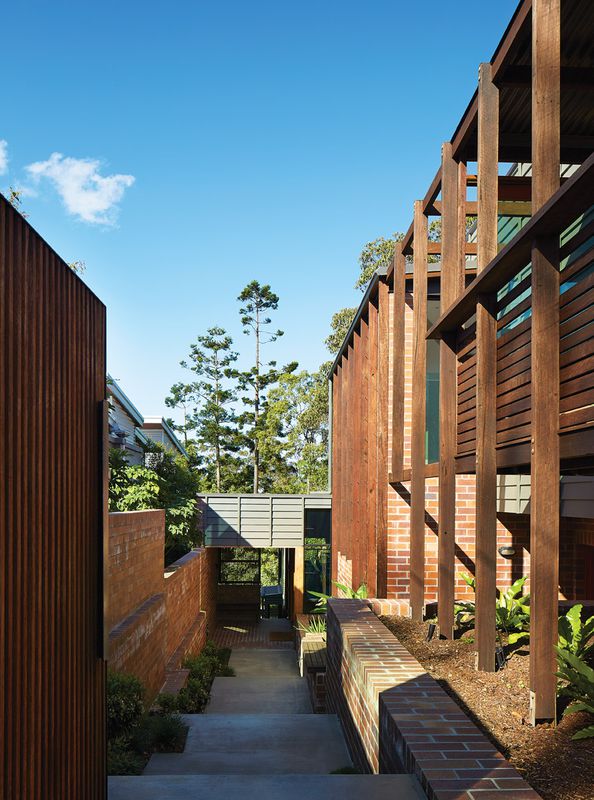Taking the thirty-kilometre drive north-west of Brisbane to the Bligh Graham Architects studio at Cedar Creek is an absorbing experience. The road winds through the foothills of the D’Aguilar Range, sandwiched between thickly forested creek banks and rocky escarpments, broken now and then by lush patches of emerald pasture dotted with cows and rusted sheds.
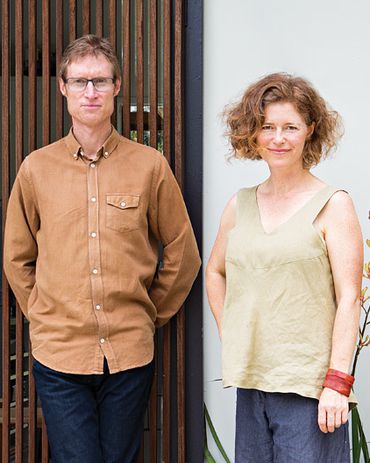
Chris Bligh and Sonia Graham — Bligh Graham Architects.
Image: Christopher Frederick Jones
The skillion-roofed studio pavilion and adjacent home, from which husband-and-wife architectural team Chris Bligh and Sonia Graham operate, is perched at the end of Dairy Farm Lane. The address may have a fairytale ring to it, but there is much rigour to the design and placement of the cul-de-sac enclave: a rigour that is reflected in the practice’s diverse portfolio of residential work.
The family’s move from inner-city Red Hill to the countryside eleven years ago was almost by accident. Working from a small timber house on a steeply sloping block in the cutely named Zig Zag Street (made famous by Nick Earls’s first novel, Zigzag Street), the couple recognized they had outgrown the house for both themselves and their “high-energy” son Jonathan, now aged eleven.
“We hadn’t really planned on a rural existence, but we happened to drive out here on a public holiday and came across this place,” says Sonia. “It was important that we could share the parenting and the work, and we were also keen to send our children to the Steiner school which is nearby.”
Chris and Sonia were captivated by the setting, which they describe as “quite other” and which stirred in Sonia memories of Tasmania, where she grew up and attended university. The five-acre plot, a former dairy farm, has a rocky mountain as its northern backdrop. The landscape unfolds before it, with a tree-lined creek slicing through the gully. The three-bedroom house and the studio and carport structure were built just in time for the birth of their second child Emily, now aged nine. The house and the pool pavilion have evolved in several stages over a decade, expanding to accommodate their youngest child, Thea, now aged five.
During that time, Chris and Sonia have acted as benevolent stewards of the land, planting over three thousand rainforest trees in a determined effort to restore it to its original state. An orchard, vegetable patch and herb spiral also allow for a high degree of self-sufficiency. The connection to nature, a prevalent theme in the work, took on a visceral aspect when they manually repositioned large granite boulders around the garden and hacked away at acres of lantana and other weeds.
Cedar Creek House and Studio (2011): The duo’s workspace offers spectacular views into the surrounding bushland.
Image: Christopher Frederick Jones
“We’ve used Cedar Creek House and Studio as a testing ground for ideas for our buildings and landscapes,” says Chris. “There are a lot of details and elements in the house that are refined or exploited in other projects.” Roof lines flow from and continue the silhouettes of the surrounding hills; openings have deep reveals, layered with sliding screens that accommodate varying degrees of security and weather protection, and are positioned to capture a perfect moment in the landscape beyond. “The budget for our own place was tight, so we’ve built a cheap envelope and elaborated on it in simple ways to gain depth and layering,” says Chris.
Like all their projects, the site and the positioning of the buildings have emphasized Bligh Graham Architects’ concern with an architecture that amplifies the relationship between people and place, and indeed heightens the inherent qualities of place. “We adopt a haptic approach to our work,” says Chris. “It is human-centred. We put the making of meaningful places ahead of a wilful need to invent.”
Chris was educated at the University of Queensland, then completed a master’s degree at the University of British Columbia. He pays tribute to UQ mentors Brit Andresen and Peter O’Gorman for their intellectual rigour and creation of a “poetic, humane architecture.” He also lists Kevin Low in Malaysia and Studio Mumbai in India – and their engagement with their subtropical locations – as strong influences on the work of Bligh Graham Architects. And Alvar Aalto, for his “unsurpassed way of thinking about architecture that was such a radical breakthrough from both Classicism and Modernism.”
Samford House (2008): This highly crafted house combines refined hand-trowlled polished plaster walls with more “rough-and-ready” materials such as recycled ironbark.
Image: Scott Burrows
In the nearby village of Samford, Bligh Graham Architects designed a highly crafted house that extends the Cedar Creek House and Studio budget considerably while using the same principles of passive ventilation and thermal massing. Samford House was built for clients with a significant art collection and a desire to live sustainably. Refined hand-trowelled polished plaster walls combine with more rough-and-ready elements such as recycled ironbark to address the owners’ “love of the outback.” A thin C-plan around a central courtyard, and a rooftop garden, allow for optimal retreat spaces.
In a recent student lecture, Chris used images of Kyoto’s Ryoan-ji temple to expound the experience of nature in a landscape setting. The similar condition of living on the edge of the city against the mountains is palpably comparable in both the Samford House and Cedar Creek House and Studio, as is the careful placement of the cluster of buildings in a planned and orchestrated landscape that is revelatory to the senses.
Fig Tree Pocket House 2 (2008): The house weaves around two internal courtyards, one on each of the two lower levels.
Image: Scott Burrows
Within this doctrine, the courtyard is a recurring motif. Fig Tree Pocket House 2 weaves around two internal courtyards, one on each of the lower two levels: the private lower court serves the chthonic space of the main bedroom, while the upper-level court provides a focus for the family rooms that look into it from three sides. The primacy of the garden, especially a food production garden, is central to much of the planning and is particularly close to Sonia’s heart. The garden-as-extended-room is explored in another way in the New Farm Studio. This delightfully poised extension to a Queenslander cottage is a treehouse that plays on the “assembly of parts” tectonics of the building to which it is grafted. Elevated rather than grounded, it is a receding box that houses the owners’ music room and office.
St Lucia House 2 (2013): The living spaces can be opened up to engage with the local bushland.
Image: Scott Burrows
St Lucia House 2 makes use of a long, skinny plan around a treasured eucalypt and engages with the local bushland. An apartment for an elderly relative can be independent of the main house, and a “family-sized” home takes up a seemingly modest piece of land. As Chris and Sonia note, building sustainably includes building homes that will see through a few different generations and their needs. It’s a natural thing.
See more of Bligh Graham Architects’ natural material pallete.
Source
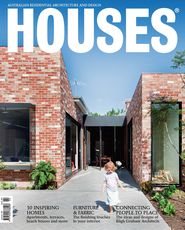
People
Published online: 9 Jul 2014
Words:
Margie Fraser
Images:
Christopher Frederick Jones,
Scott Burrows
Issue
Houses, April 2014

